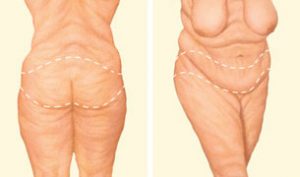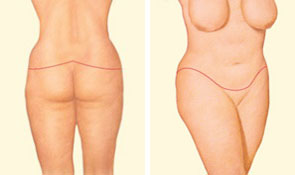What is a body lift?
A body lift improves the shape and tone of the underlying tissue that supports skin and fat. Excess sagging skin and fat are removed and the procedure(s) can improve a dimpled, irregular skin surface.A body lift may include these areas
- Abdominal area – locally or extending around the sides and into the lower back area
- Buttocks
- Thigh – the inner, outer or posterior thigh, or the thigh’s circumference
What a body lift can’t do
Body lifts are not intended strictly for the removal of excess fat. Liposuction alone can remove excess fat deposits where skin has good elasticity and is able to naturally conform to new body contours. In cases where skin elasticity is poor, body lift techniques along with liposuction may be recommended.Who is a good candidate for body lift surgery?
In general, body lift candidates include:
- Individuals with significant soft tissue looseness in one or multiple body areas
- Healthy individuals without medical conditions that impair healing or increase risk of surgery
- Individuals with a positive outlook and realistic goals for what body lift surgery can accomplish
- Nonsmokers
- Individuals committed to leading a healthy lifestyle with proper nutrition and fitness
What questions should I ask my plastic surgeon about body lift surgery?
Use this checklist as a guide during your body lift consultation:
- Are you certified by the American Board of Plastic Surgery?
- Were you specifically trained in the field of plastic surgery?
- How many years of plastic surgery training have you had?
- Do you have hospital privileges to perform this procedure? If so, at which hospitals?
- Is the office-based surgical facility accredited by a nationally- or state-recognized accrediting agency, or is it state-licensed or Medicare-certified?
- Am I a good candidate for this procedure?
- What will be expected of me to get the best results?
- Where and how will you perform my procedure?
- What surgical technique is recommended for me?
- How long of a recovery period can I expect, and what kind of help will I need during my recovery?
- What are the risks and complications associated with my procedure?
- How are complications handled?
- How can I expect my body to look over time? After pregnancy?
- What are my options if I am dissatisfied with the cosmetic outcome of my body lift?
- Do you have before-and-after photos I can look at for this procedure and what results are reasonable for me?
What questions should I ask my plastic surgeon about arm lift surgery?
Use this checklist as a guide during your arm lift surgery consultation:
- Are you certified by the American Board of Plastic Surgery?
- Were you specifically trained in the field of plastic surgery?
- How many years of plastic surgery training have you had?
- Do you have hospital privileges to perform this procedure? If so, at which hospitals?
- Is the office-based surgical facility accredited by a nationally- or state-recognized accrediting agency, or is it state-licensed or Medicare-certified?
- Am I a good candidate for this procedure?
- What will be expected of me to get the best results?
- Where and how will you perform my procedure?
- What surgical technique is recommended for me?
- How long of a recovery period can I expect, and what kind of help will I need during my recovery?
- What are the risks and complications associated with my procedure?
- How are complications handled?
- How can I expect my arms to look over time?
- What are my options if I am dissatisfied with the cosmetic outcome of my arm lift?
- Do you have before-and-after photos I can look at for this procedure and what results are reasonable for me?
What are the risks of body lift surgery?
The decision to have plastic surgery is extremely personal. You will have to decide if the benefits will achieve your goals and if the risks and potential complications of body lift surgery are acceptable.
Your plastic surgeon and/or staff will explain in detail the risks associated with surgery. You will be asked to sign consent forms to ensure that you fully understand the procedure you will undergo and any risks or potential complications.Possible body lift surgery risks include:
- Anesthesia risks
- Bleeding (hematoma)
- Infection
- Poor wound healing
- Fluid accumulation
- Numbness or other changes in skin sensation
- Fatty tissue under the skin might die (fat necrosis)
- Pain, which may persist
- Recurrent looseness of skin
- Persistent swelling in the legs
- Skin discoloration and/or prolonged swelling
- Asymmetries
- Deep vein thrombosis, cardiac and pulmonary complications
- Possible need for revisionary surgery
- Skin loss
- Sutures may spontaneously surface through the skin, become visible or produce irritation and require removal
- Unfavorable scarring
These risks and others will be fully discussed prior to your consent. It is important that you address all your questions directly with your plastic surgeon.
How should I prepare for body lift surgery?
In preparing for arm lift surgery, you may be asked to:
- Get lab testing or a medical evaluation
- Take certain medications or adjust your current medications
- Stop smoking
- Avoid taking aspirin, anti-inflammatory drugs and herbal supplements as they can increase bleeding
Body lift surgery may be performed in an accredited office-based surgical facility, ambulatory surgical center or a hospital.
If your body lift is performed on an outpatient basis, be sure to arrange for someone to drive you to and from surgery, and to stay with you for at least the first night following surgery.
What are the steps of a body lift procedure?
Body lift procedures are surgical procedures and they require extensive incisions. Incision length and pattern depend on the amount and location of excess skin to be removed, as well as surgical judgment.
Advanced techniques usually allow incisions to be placed in strategic locations where they can be hidden by most types of clothing and swimsuits.
Step 1 – Anesthesia
Medications are administered for your comfort during the surgical procedure. The choices include intravenous sedation and general anesthesia. Your doctor will recommend the best choice for you.
Step 2 – The incision
One common technique of complete lower body lift uses incisions similar to a bikini pattern to tighten the abdomen, groin, waist, thigh and buttock in one procedure. An incision around the body removes an apron of excess skin and fat and repositions and tightens tissues.

Surgical body lifts may require liposuction to achieve an improved contour.
Step 3 – Closing the incisions
Deep sutures within underlying tissues help to form and support the newly shaped contours. Sutures, skin adhesives, tapes or clips may be used to close the skin incisions.

Step 4 – See the results
The results of a body lift are visible almost immediately. It may take as long as one to two years for the final results to fully develop. Get more information on body lift results.
What should I expect during my body lift recovery?
During your body lift surgery recovery, dressings or bandages will be applied to the incisions after the procedure is complete. Small, thin tubes may be temporarily placed under the skin to drain any excess blood that may collect.
You will be given specific instructions that may include:
- How to care for your surgical site(s) following surgery
- Medications to apply or take orally to aid healing
- Specific concerns to look for at the surgical site or in your general health
- How to care for your drains
- When to follow up with your plastic surgeon
Be sure to ask your body lift surgeon specific questions about what you can expect during your individual recovery period:
- Where will I be taken after my surgery is complete?
- What medication will I be given or prescribed after surgery?
- Will I have dressings/bandages after surgery? When will they be removed?
- When can I bathe after surgery and how may I bathe?
- Are stitches removed? When?
- When will the drains be removed?
- When can I resume normal activity, driving and exercise?
- When do I return for follow-up care?
Body lift surgery recovery at home
If you experience shortness of breath, chest pains or unusual heartbeats, seek medical attention immediately. Should any of these complications occur, you may require hospitalization and additional treatment.
What results should I expect after body lift surgery?
The results of body lift surgery are visible almost immediately. However, it may take two years or more for the final results of the body lift procedures to fully develop.
Some visible scars will remain, but the overall results are long lasting, provided that you maintain a stable weight and general fitness. As your body ages, it is natural to lose some firmness.
However, most of your initial improvement should remain.
Although good results are expected from your body lift surgery, there is no guarantee. In some situations, it may not be possible to achieve optimal results with a single surgical procedure and another surgery may be necessary.
Following your physician’s instructions is essential to the success of your surgery.
It is important that the surgical incisions are not subjected to excessive force, motion, swelling or abrasion during the time of healing. Your doctor will give you specific instructions on how to care for yourself.
What words should I know about body lift surgery?
Abdominoplasty
A surgical procedure to correct the apron of excess skin hanging over your abdomen.
Circumferential incision
A surgical incision around the body to remove the “belt” of excess skin and fat and additional incisions that may resemble a bikini bottom pattern.
Circumferential thigh lift
A surgical procedure to correct sagging of the outer and mid-thigh.
General anesthesia
Medications that are inhaled and/or given by injection through a vein used during an operation to relieve pain and alter consciousness.
Hematoma
Blood pooling beneath the skin.
Intravenous sedation
Sedatives administered by injection into a vein to help you relax.
Liposuction
Also called lipoplasty or suction lipectomy, this procedure vacuums out fat from beneath the skin’s surface to reduce fullness.
Local anesthesia
A medication injected directly to the site of an incision during an operation to relieve pain.
Lower body lift
Surgical procedure to correct sagging of the abdomen, buttocks, groin and outer thighs.
Medial thigh lift
A surgical procedure to correct sagging of the inner thigh.
Sutures
Stitches used by surgeons to hold skin and tissue together.
Tummy tuck
A surgical procedure to correct the apron of excess skin hanging over your abdomen.
How do I choose a plastic surgeon for body lift surgery?
Body lift surgery involves many choices. The first and most important is selecting a board-certified plastic surgeon you can trust who is a member of the American Society of Plastic Surgeons (ASPS).
ASPS member surgeons meet rigorous standards:
- Board certification by the American Board of Plastic Surgery® (ABPS) or in Canada by the Royal College of Physicians and Surgeons of Canada®
- Complete at least six years of surgical training following medical school with a minimum of three years of plastic surgery residency training
- Pass comprehensive oral and written exams
- Graduate from an accredited medical school
- Complete continuing medical education, including patient safety, each year
- Perform surgery in accredited, state-licensed, or Medicare-certified surgical facilities
Do not be confused by other official-sounding boards and certifications.
The ABPS is recognized by the American Board of Medical Specialties (ABMS), which has approved medical specialty boards since 1934. There is no ABMS recognized certifying board with “cosmetic surgery” in its name.
By choosing a member of the American Society of Plastic Surgeons, you can be assured that you are choosing a qualified, highly-trained plastic surgeon who is board-certified by the ABPS or the Royal College of Physicians and Surgeons of Canada.
